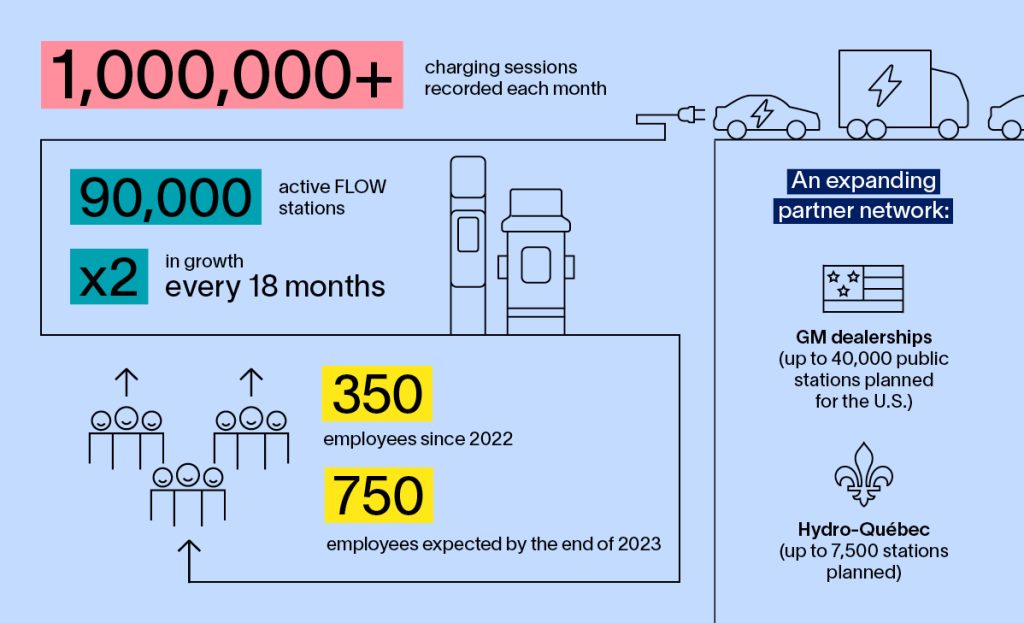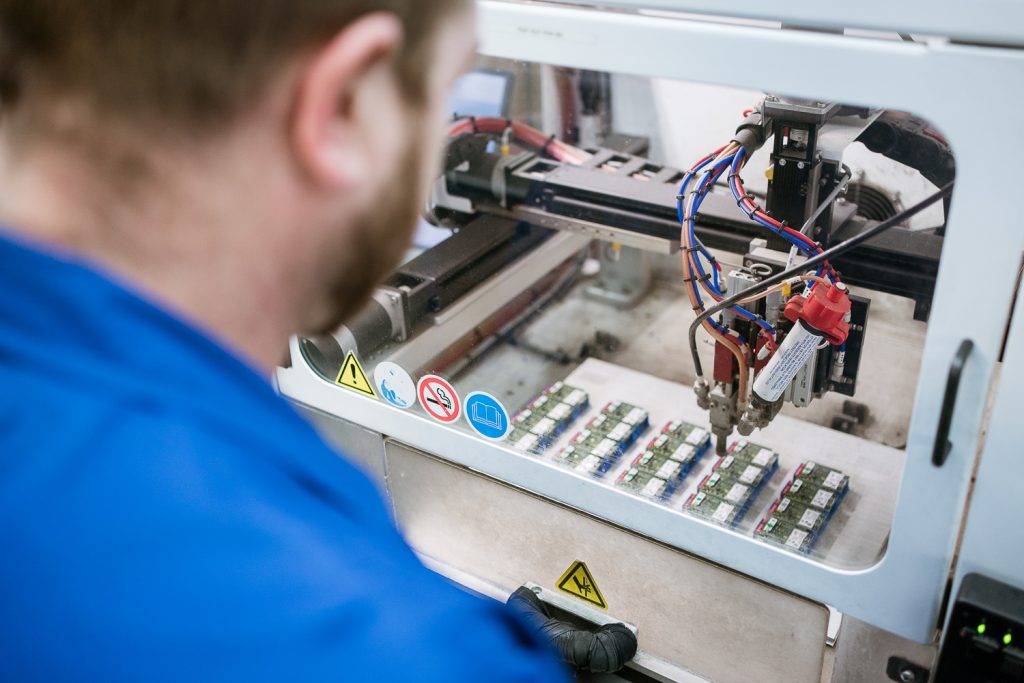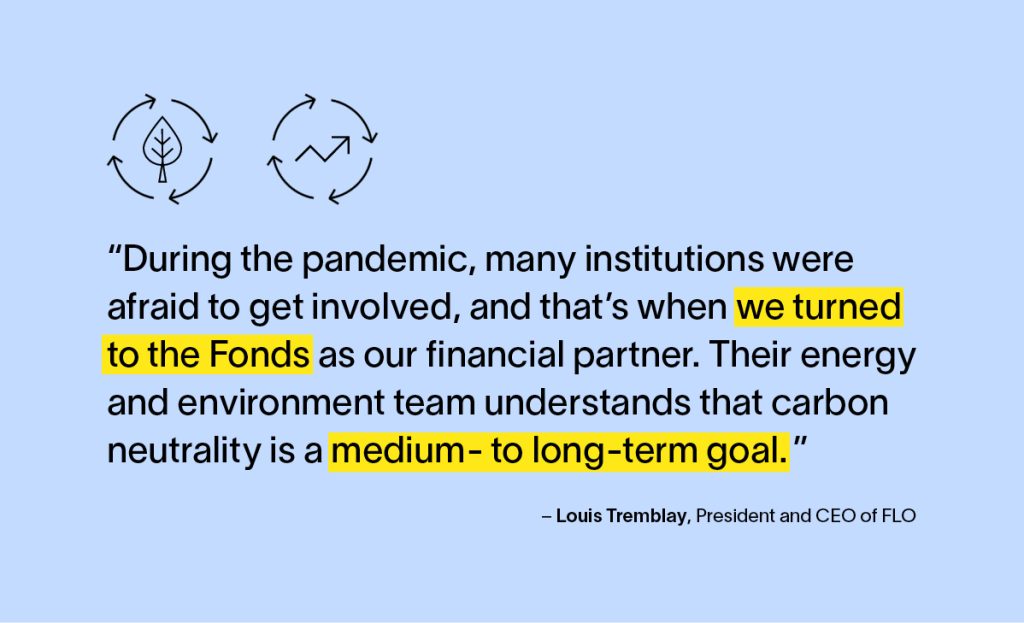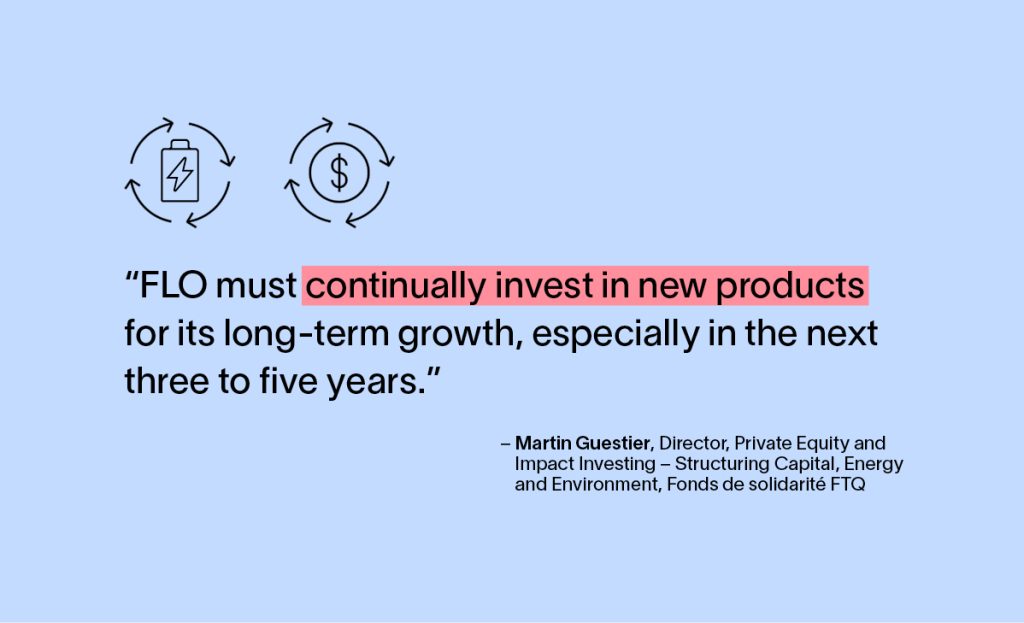FLO®: sparking change, one charge at a time

FLO became a leader in electric vehicle (EV) charging in North America by integrating the process from start to finish: manufacturing charging stations, developing software and managing its network. To stay ahead of the curve in a fast-moving, innovation-driven market, the company turned to the Fonds de solidarité FTQ to support its growth.
“I was definitely born at the right time and at the right place,” says Louis Tremblay, President and CEO of FLO.
As a natural entrepreneur and a lifelong car enthusiast, he understands the importance of acting on climate issues. An electric vehicle project at Université Laval in 2004 sparked his focus on the key to accelerating the shift to EVs: charging. Since Québec has a wealth of engineering skills, both electrical and software, he’s confident the province has what it takes to “get it right and do it efficiently.” Today, the company he founded in 2009 is a market leader offering a wide range of products and an extensive charging network, one of the largest across Canada and the United States.


If the EV adoption rate has accelerated recently, it’s not just because of the incentives from our governments to meet their emissions targets; it’s because visionaries like FLO have paved the way with a highly reliable, robust and innovative infrastructure.
“When you look at the budgets for vehicle electrification in North America over the last two years, the tide has definitely turned,” Tremblay adds. “For years, we were like surfers waiting for the perfect wave. Gradually, we developed our products and software for different market segments, and now we’re deploying more charging stations than ever to ride the big incoming wave!”
It’s all about the experience
The company—based in Québec City with two plants in Shawinigan and one added in Michigan this winter—owes its solid growth to a simple vision: to offer the best charging experience possible.
“We had to make sure that early adopters of this technology didn’t get stranded at the side of the road. That’s why, from the very beginning, we integrated everything under one roof: manufacturing charging stations, developing and managing mobile apps and managing the network. Integration gives us more control over the charging experience, compared to vendors who focus on one part of the equation,” Tremblay says.
Integration means that FLO can compete with players across North America that just can’t offer the same reliability and availability. For instance, a 2022 UC Berkeley study found that only 72.5% of all public stations in the San Francisco Bay Area were functional. FLO, on the other hand, guarantees 98% uptime at all times.
And then there’s charging time: the all-new FLO UltraTM station charges most batteries up to 80% in 15 minutes with an output of up to 320 kW (depending on EV type, configuration and on the number of vehicles using the station). That’s enough power for a 200- to 300-kilometre range in the time it takes to enjoy a snack or a coffee. And it should convince sceptics that it’s time to make the leap to electric.
“EV drivers need to feel confident to explore, like taking road trips or vacations. Most of them charge at home, but “garage orphans” don’t have charging equipment at home. That’s why we prioritized on-street charging stations in 2014, at the same time as commercial fleets and condos, before entering the residential market in 2017. With ultra-fast, we’re going to meet those needs even better,” Tremblay adds.
What’s more, the FLO UltraTM station charging station is ushering in a new era of managing fleet charging stations. With over 200 sensors connected to the network, technicians can respond to alerts instead of doing routine checks, one of the many benefits of being empowered by data collection.

Invest today to stay ahead of the curve
Delivering this kind of feats requires a sustained effort in terms of development and continuous improvement. But investors aren’t always ready to enter this market because it takes considerable long-term resources.

“Environmental technology is a high-velocity market and it’s evolving along with legislation and the demand for efficient, robust products. That’s why it’s important for investors to understand the industry and its issues if they want to move forward into the future. The Fonds de solidarité FTQ’s team of energy and environmental experts know how to align with an entrepreneur’s vision,” says Martin Guestier, Director, Private Equity and Impact Investing – Structuring Capital, Energy and Environment.
A patient, present partner
The Fonds is as a patient institution that reinvests in its partner companies for long-term growth. It’s also an investor with deep pockets, with more than $17 billion in net assets, replenished year after year by contributions from its shareholders-savers. In fact, over the past five years, it has invested an average of $1.3 billion annually in local companies.
The Fonds’ goal is to hold $12 billion in net assets in sustainable development by 2027. This will allow it to create business synergies between various players in the sector while supporting the energy transition and electrification of transportation.
“We’ve been talking about sustainable development for 40 years, but there’s a real momentum for climate technologies,” Guestier adds. “We’re building the industry of the future and that demands the economic infrastructure of tomorrow.”

To learn more about Fonds de solidarité FTQ financing, visit fondsftq.com/en/business
Continue reading on the subject

The challenges of designing a 40-tonne, 100% electric mining vehicle for open-pit mines
Partnerships and implications The partners involved in the development of a 100% electric Quebec mining vehicle were all eager to be involved with the project from the outset, for a variety of reasons. NRC’s Eddy Zuppel explained their contribution: “Before starting the project, it was important to model and simulate the vehicle’s route in order […]
Read more
Energy efficiency: Financial support to put your ideas into action
Leading a company involves balancing several priorities at the same time. Energy efficiency? It’s an important issue—one of many! What if we gave you what you need to make energy efficiency a driving force behind your company’s performance and profitability? The good news is, Hydro-Québec offers financial assistance and guidance to help you balance performance and energy efficiency.
Read more
My Consumption Profile: data that lets you strategically manage your electricity use
Companies have a critical role to play in the energy transition. Knowing that energy efficiency factors big into profitability, your organization will benefit from strategically managing its electricity use. The key? Your data!
Read more
Electrifying school bus fleets : Grants available to support your project
In this series of articles, we demystify the key steps of converting your school bus fleet to electric power thanks to the Transporteur+ guide. This guide aims to provide easy and direct access to resources to clarify the steps, issues, conditions and facilitating measures for a successful transition to electrification.
Read more
Electrifying school bus fleets | Key step : Comissioning
In this series of articles, we demystify the key steps of converting your school bus fleet to electric power thanks to the Transporteur+ guide. This guide aims to provide easy and direct access to resources to clarify the steps, issues, conditions and facilitating measures for a successful transition to electrification.
Read more
FINANCING | $50 million from Finalta Capital in non-dilutive financing dedicated to the Electric and Smart Transportation sector
Fast growing, innovative companies from the electric and smart transportation (EST) sector in Québec take advantage of the $50 million in funding dedicated to the EST ecosystem by Finalta Capital, one of Canada’s largest funds specialized in non-dilutive tax credit and government grant financing, announced in March 2023 as part of the Impulsion conference, the International EST Summit organized by Propulsion Québec.
Read more
Demand response: Save money by using hydro at the right times
If you could lower your company's hydro bill while contributing to the collective effort to support Quebec’s energy transition, would you? Yes, most likely! How? By curbing power demand for buildings and equipment during peak demand events.
Read more
Electrifying school bus fleets : The importance of adapting buildings and infrastructure
In this series of articles, we demystify the key steps of converting your school bus fleet to electric power thanks to the Transporteur+ guide. This guide aims to provide easy and direct access to resources to clarify the steps, issues, conditions and facilitating measures for a successful transition to electrification.
Read more
Electrifying school bus fleets : Implementing the pilot project and phase-in
In this series of articles, we demystify the key steps of converting your school bus fleet to electric power thanks to the Transporteur+ guide. This guide aims to provide easy and direct access to resources to clarify the steps, issues, conditions and facilitating measures for a successful transition to electrification
Read more
Electrifying school bus fleets: The importance of choosing your suppliers
In this series of articles, we demystify the key steps of converting your school bus fleet to electric power thanks to the Transporteur+ guide. This guide aims to provide easy and direct access to resources to clarify the steps, issues, conditions and facilitating measures for a successful transition to electrification.
Read more
The key to a successful school bus fleet electrification project
In this series of articles, we demystify the key steps of converting your school bus fleet to electric power thanks to the Transporteur+ guide. This guide aims to provide easy and direct access to resources to clarify the steps, issues, conditions and facilitating measures for a successful transition to electrification.
Read more
A TRIBUTE TO THE WOMEN IN OUR ECOSYSTEM – A portrait of the situation in the public domain
For a long time, the transportation sector consisted mostly of men. In the past ten years or so, more and more women can be found around discussion tables, in management roles and on executive boards of different leading corporations and organizations in our ecosystem.
Read more




